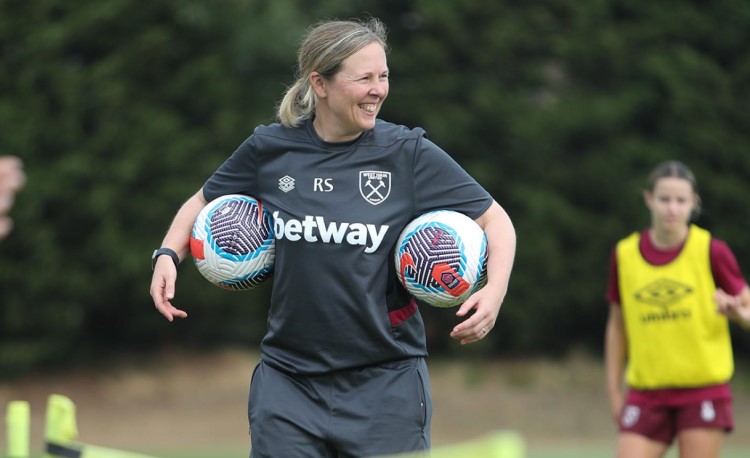You are viewing 1 of your 1 free articles
Changing the point of attack
This session allows players to be creative in finding solutions to change the point of attack, to exploit the weak side of the opposition and progress the attack.
| Area | Up to full pitch |
| Equipment | Ball, bibs, cones, 2 mini goals, 2 full size goals, poles |
| No. of Players | Up to 20 players + 2 goalkeepers |
| Session Time |
Directional practice: 10 mins 11v11 midfield third: 20 mins 11v11 developing possession: 20 mins |
This session allows players to be creative in finding solutions to change the point of attack, to exploit the weak side of the opposition and progress the attack.
It challenges the players to think about how to create and recognise space through all positions, making it effective to support team structure and philosophy.
We start with a directional practice, in which teams must switch the play from one side to the other in order to change the point of attack.
We then move on to an 11v11 in the midfield third, before finishing with an 11v11 on the full pitch.
This session – or parts of it – are delivered on a regular basis to fit the principles and style of play that I want my teams to play.
DIRECTIONAL PRACTICE
We set up a playing area of 52x30 yards with two end zones 6-yards wide, split into two. We’re using 16 players, split into two teams of six in the middle, and one player in each of the side areas allocated to wide players.
The yellows play for the team in possession and always play back inside, not yellow to yellow.
The blue team set up in a 4-3-3 formation (formation can be flexible based on opponent structure) with the yellows acting as their full-backs and wide attacking players. The red team set up in a 5-2-3 formation, with the yellows acting as their wing-backs and wide attacking players.
The aim is for the team in possession to find wide yellows, maintaining possession from one side of the pitch to the other to change the point of attack. A successful switch earns the team a goal, as shown [1a].
[1a]
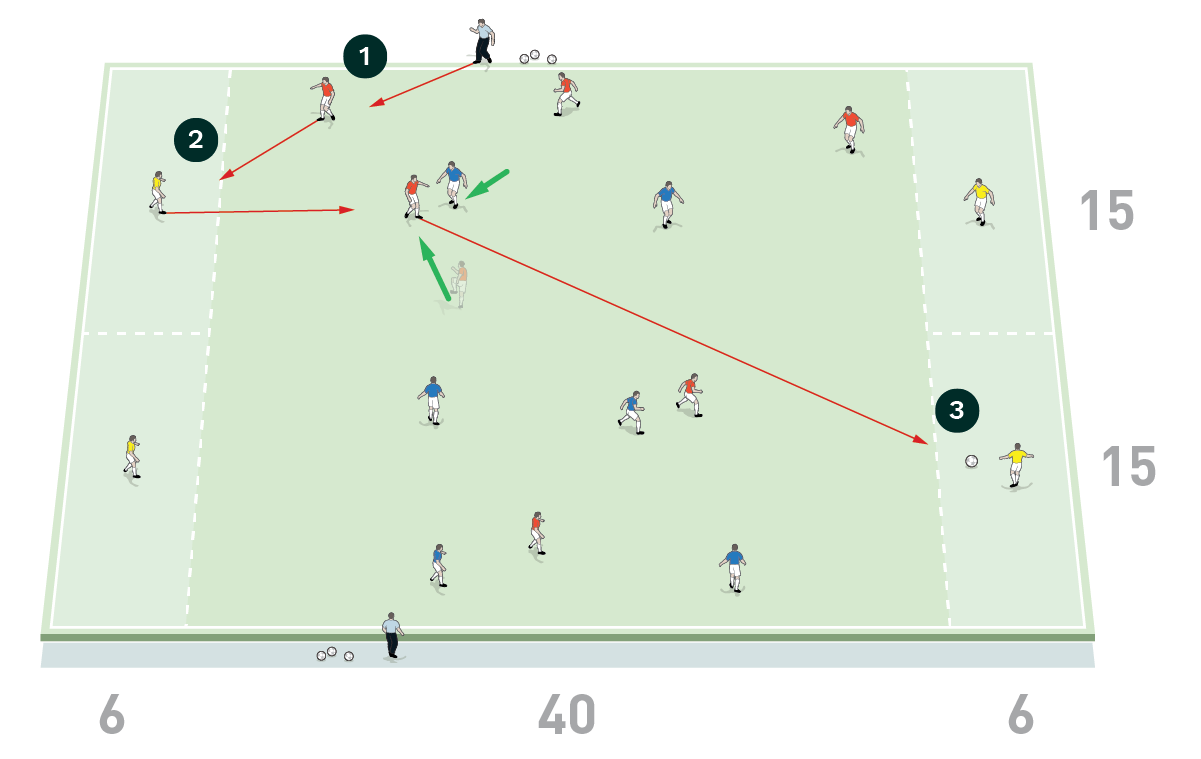
-
The coach plays the ball in to the red team to start the exercise
-
The red player plays it to a yellow player, who plays it back in to a red
-
The red player switches play, changing the point of attack and earning the red team a goal
After a goal has been earned, the ball remains in play. Players must focus on controlling and keeping possession throughout until the other team wins possession and follows the same process, as shown [1b].
[1b]
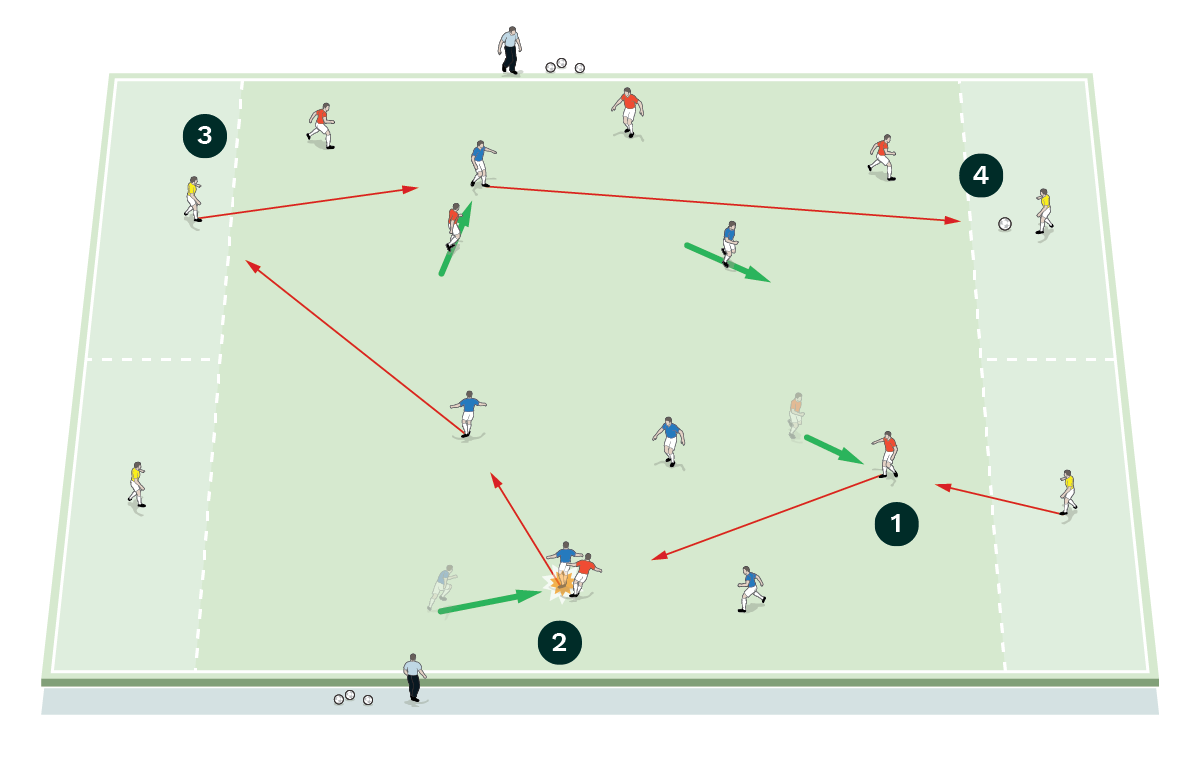
-
Play continues, the yellow player plays it back into a red
-
This player plays the ball to another red, but is tackled by a blue
-
The blues work the ball to the yellow on the other side of the pitch
-
The blues switch the point of attack and earn themselves a goal
The formational set up in central areas can be varied depending on opposition and will link in to pressing strategies naturally via the set up. We run this practice for three blocks of three minutes each.
11V11 MIDFIELD THIRD
We set up an area in the middle third, 55 yards long, with the full width of the pitch used. Full size goals are used at each end, as well as two mini goals either side, on an angle, and two sets of poles, nearer to the corner, as shown.
We’re using 22 players, including two goalkeepers, split into two teams of 11. Both teams are set up in a 5-2-3 formation (again, formation can vary but principles remain the same).
The game can start from the goalkeeper, but most often starts with a throw in for the repetition of the opportunity to practice set up and recognise ways to change the point of attack.
Teams must look to score either in the central goal [2a] or by dribbling through the side goals and passing into one of the small goals, replicating a connection inside the pocket [2b].
[2a]
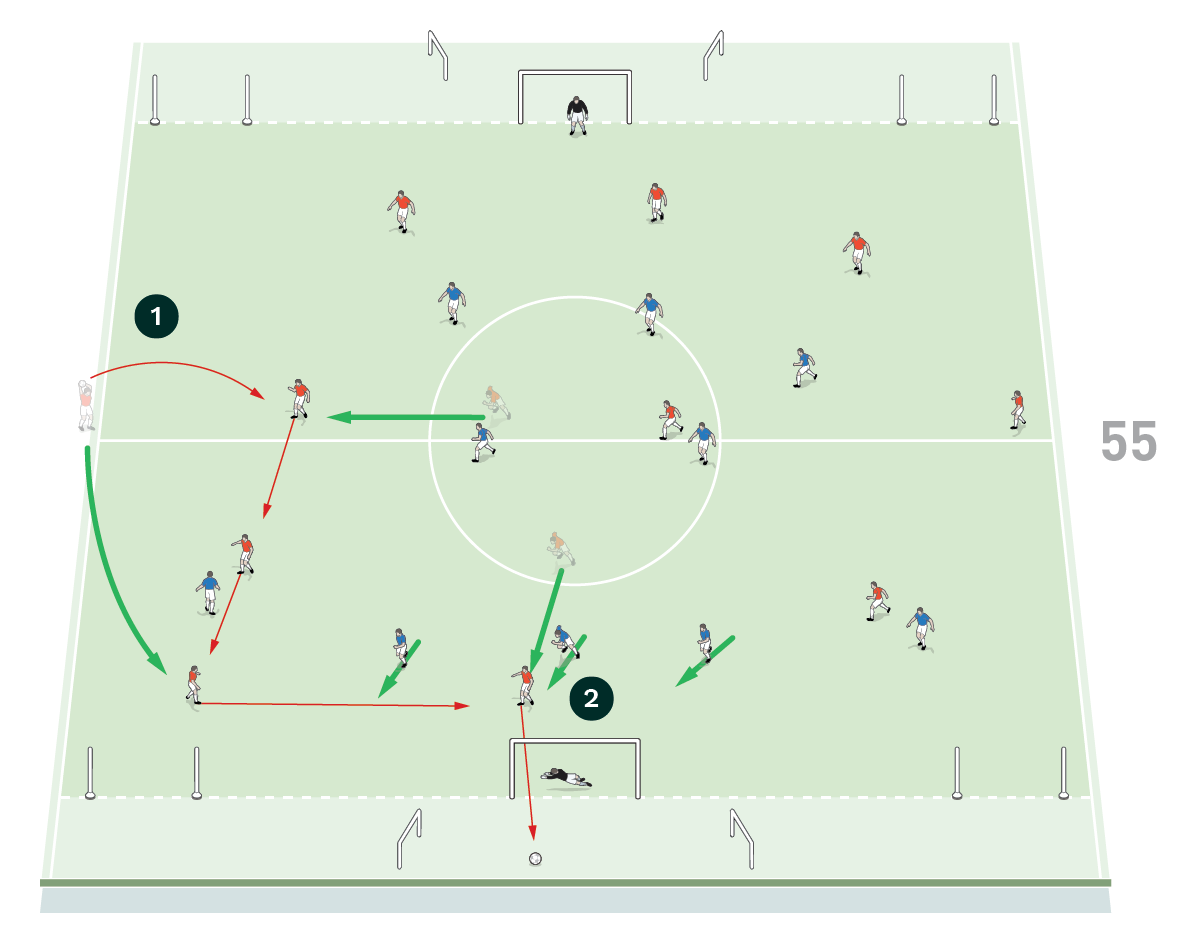
-
Play starts with a red throw-in
-
The red team score in the main goal to win a point
[2b]
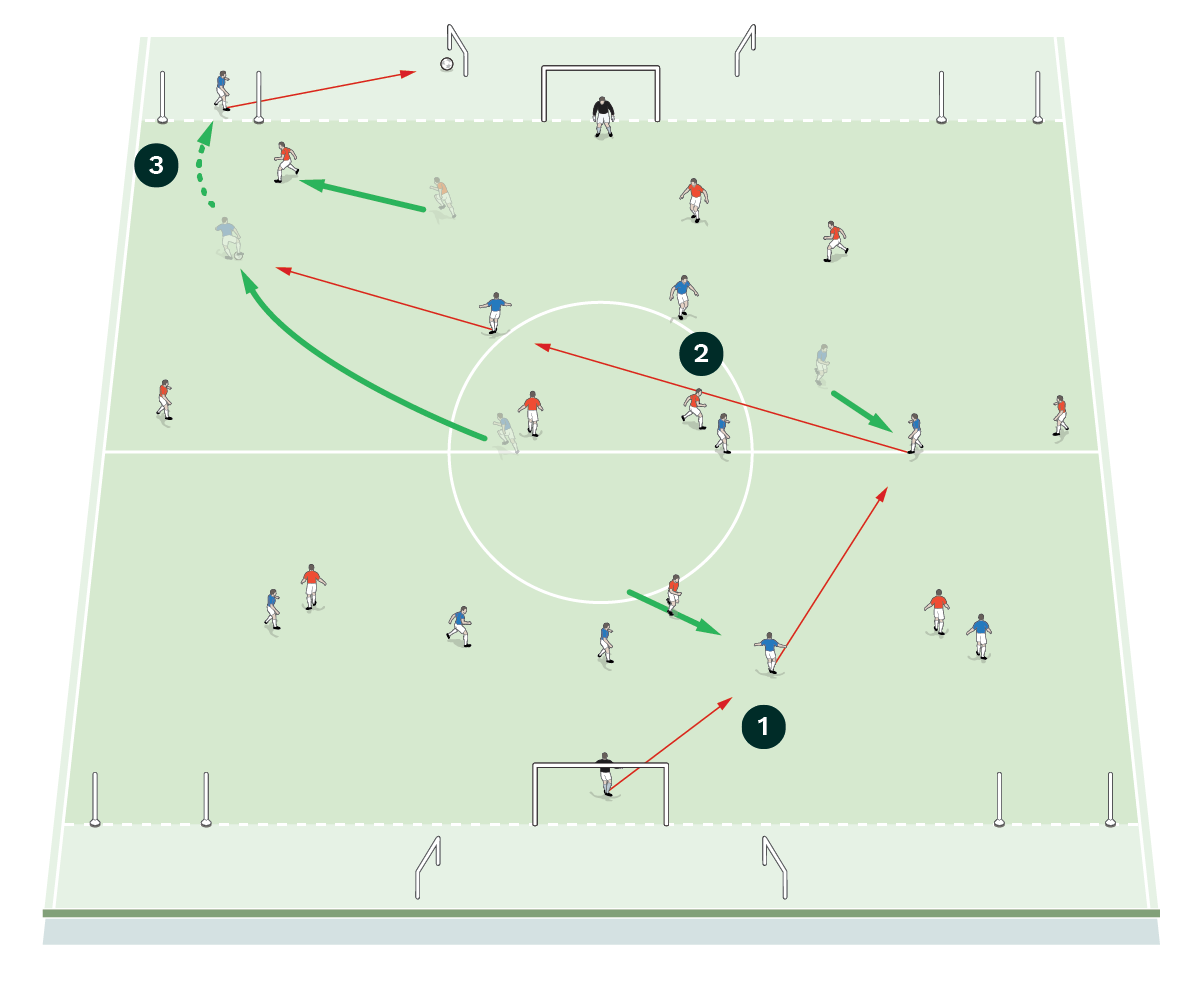
-
Play starts from the blue goalkeeper
-
The blue team aim to work the ball from the right to the left
-
The blues score a point by dribbling through the side poles and passing into the small goal
The central goals and mini goals allow players to make decisions on which is the most effective way to exploit the opposition, whether that be around or through them, having stretched the opponents’ defence.
We run this practice for two blocks of eight minutes each.
11V11 DEVELOPING POSSESSION
We set up on the full pitch with full size goals. We’re using 22 players, including two goalkeepers, split into two teams of 11.
This game is an opportunity to highlight key areas to exploit the opposition whilst working on principles of attacking play [3].
[3]
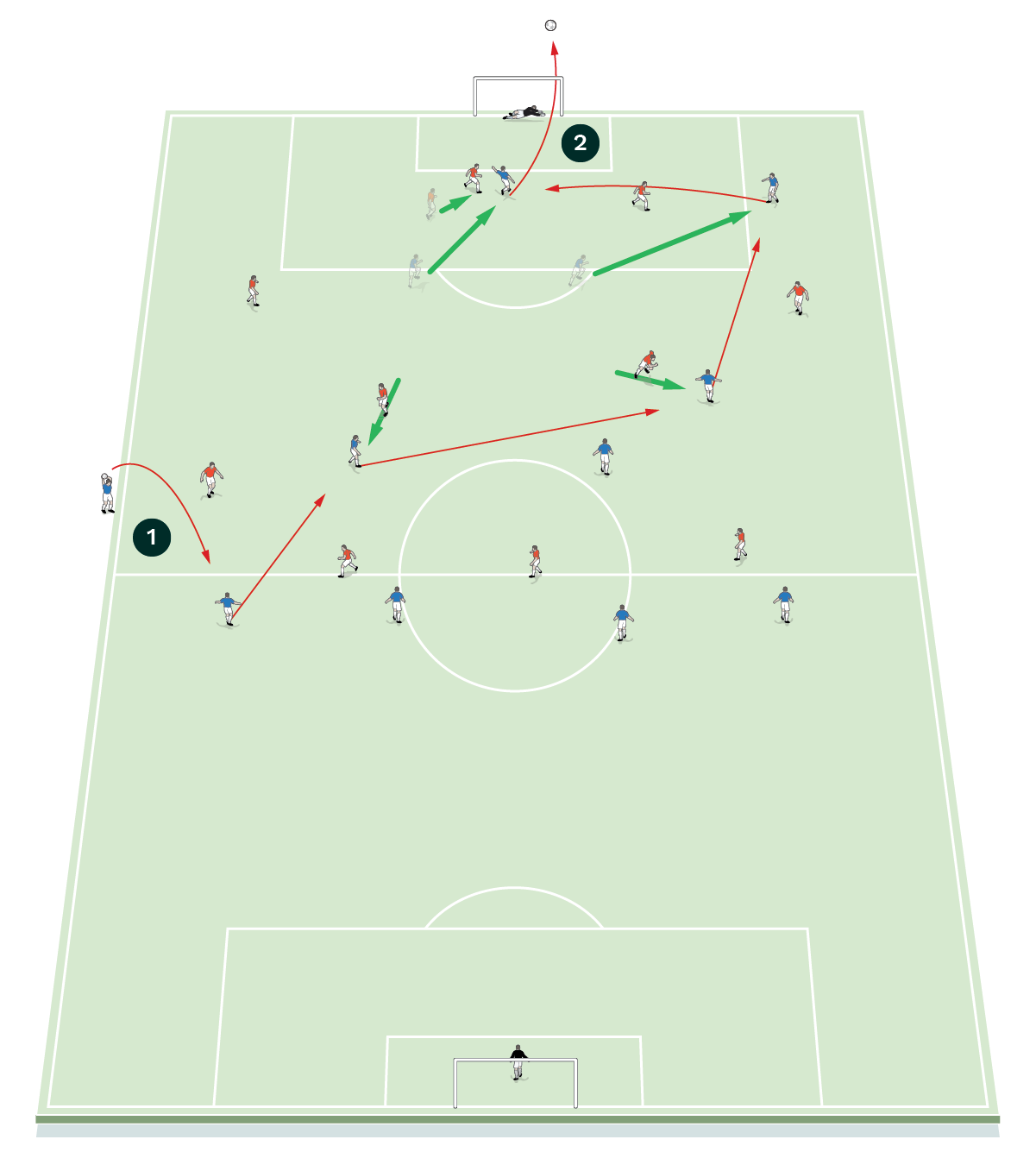
-
The blue team start from a throw-in
-
The team combines to switch play and create a goalscoring opportunity
Restarts can vary organically.
We run this practice for two blocks of eight minutes each.
What are the key things to look out for?
The spine of the team – the centre back, centre midfielder and striker – must think about supporting positions, angles, timing, awareness and body shape to receive in order to change the point of attack through themselves or create combinations that allow them to do so.
Players are focusing on creating space, covering all five lanes of the pitch and drawing the press on one side to change the point of attack with speed to exploit the other and create overloads. They must recognise the most effective space to exploit, whether that be centrally to break lines or going around by changing the point of attack to exploit wide areas.
Teams should look to draw the press and recognise whether it gives them space to change the point of attack from under the ball, from the defenders or goalkeeper via the midfield, or through to the frontline to either receive to face up or set back.
Players will be tested on their decision making when receiving based on pressure, and should consider their first touch, ball protection, disguise and opening up the pitch.
What are the typical mistakes players might make and how can they be avoided?
Players will choose to play the conditions, as opposed to the scenario they are presented with when it isn’t always available to change the point of attack (CPOA); as a result, they can try to force the ball into unrealistic areas.
The better players who can quickly adapt will be more patient, looking to keep possession longer before finding the right time to receive to switch.
The session often sees people not set their body shape well enough to open the pitch, so the first touch might see the player play back into pressure as opposed to trying to come out on the front foot.
Players can also miss great opportunities to go central after a switch, due to thinking about going to the opposite side despite the CPOA having already opened space to progress up the pitch.
Related Files

Rehanne Skinner
Editor's Picks
Deep runs in the final third
Using the goalkeeper in build-up play
Pressing principles
Intensive boxes drill with goals
Penetrating the final third
Creating and finishing
My philosophy
Pressing initiation
Compact team movement
Coaches' Testimonials

Alan Pardew

Arsène Wenger

Brendan Rodgers

Carlos Carvalhal

José Mourinho

Jürgen Klopp

Pep Guardiola

Roy Hodgson

Sir Alex Ferguson

Steven Gerrard
Coaches' Testimonials

Gerald Kearney, Downtown Las Vegas Soccer Club

Paul Butler, Florida, USA

Rick Shields, Springboro, USA

Tony Green, Pierrefonds Titans, Quebec, Canada
Join the world's leading coaches and managers and discover for yourself one of the best kept secrets in coaching. No other training tool on the planet is written or read by the calibre of names you’ll find in Elite Soccer.
In a recent survey 92% of subscribers said Elite Soccer makes them more confident, 89% said it makes them a more effective coach and 91% said it makes them more inspired.
Get Monthly Inspiration
All the latest techniques and approaches
Since 2010 Elite Soccer has given subscribers exclusive insight into the training ground practices of the world’s best coaches. Published in partnership with the League Managers Association we have unparalleled access to the leading lights in the English leagues, as well as a host of international managers.
Elite Soccer exclusively features sessions written by the coaches themselves. There are no observed sessions and no sessions “in the style of”, just first-hand advice delivered direct to you from the coach.
